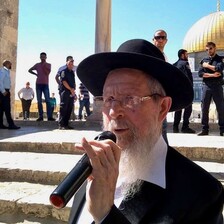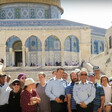The Electronic Intifada 21 April 2020

Baruch Ben Yosef is the chief suspect in the 1985 assassination of a Palestinian American activist.
The long-awaited “Middle East peace plan,” unveiled in January by the US administration, has been widely panned for effectively approving Israel’s annexation of vast swaths of occupied territory and extinguishing the hope that Palestinians would form a viable state of their own on a significant portion of their historic homeland.
But there is another reason that Donald Trump’s plan should be of cause for concern.
Its proposal to permit Jews to pray at the premier Islamic holy site in Jerusalem is so biased in Israel’s favor that it fulfills the decades-old demands of one of the country’s most extreme political figures: Baruch Ben Yosef, a top suspect in the 1985 murder of Palestinian American civil rights leader Alex Odeh and a former right-hand man of the arch-racist Rabbi Meir Kahane.
In an article published by The Intercept in February, this writer revealed that Ben Yosef, who grew up in New York City as Andy Green, is one of the FBI’s top suspects in a string of bombings that maimed and murdered US citizens on both coasts of the US in 1985.
According to numerous active and retired law enforcement agents who have worked on the cases, Ben Yosef and two other followers of Kahane – Keith Israel Fuchs and Robert Manning – are suspected of assassinating Odeh on 11 October 1985, by planting a bomb at the offices of the American Arab Anti-Discrimination Committee in Santa Ana, California, where Odeh served as the organization’s West Coast regional director.
Ben Yosef returned to Israel the following year, and since the early 1990s has spearheaded efforts to secure Jewish prayer rights in the al-Aqsa mosque compound, home of the al-Aqsa mosque, the third holiest site in Islam, and another iconic shrine, the golden-capped Dome of the Rock.
Muslims refer to the compound as al-Haram al-Sharif, and Jews refer to it as the Temple Mount, after the Jewish temples that stood on that same spot in ancient times.
But after Roman forces destroyed the last Jewish temple almost 2,000 years ago, the plaza remained vacant for 600 years. Only then did Muslims build at that same location the Dome of the Rock, instantly recognizable today as the crown jewel of the Jerusalem skyline.
The adjacent al-Aqsa mosque was added to the site more than a decade later. Today, the two structures and the 36-acre courtyard they sit on are considered a site of national importance for Palestinians of all faiths.
After it occupied the al-Aqsa mosque compound in 1967 – along with the rest of East Jerusalem, the West Bank, the Gaza Strip, the Syrian Golan Heights and the Egyptian Sinai Peninsula – Israel raised its flag atop the Dome of the Rock. Shlomo Goren, then the Israeli military’s chief rabbi, established a Jewish house of learning on the premises.
Within months, however, Israel removed the religious academy and other signs of its sovereignty.
For the last five decades, the premises have been presided over by the Islamic Waqf, a body sanctioned by neighboring Jordan, which controlled the territory from 1948 to 1967 and remains responsible for Muslim holy sites in Jerusalem.
Despite nominal Jordanian custodianship of the site, Israel maintains full control. It regularly raids the compound, bars Palestinians from worshipping at holy sites and habitually arrests them.
Trump’s plan to permit Jews to pray on the al-Aqsa mosque compound would upend the precarious status quo that has uneasily prevailed there for decades.
“People of every faith should be permitted to pray on the Temple Mount/al-Haram al-Sharif, in a manner that is fully respectful to their religion, taking into account the times of each religion’s prayers and holidays, as well as other religious factors,” the plan states.
If Trump’s proposal came into effect, it would reward some of the most reactionary forces in Israel, who see securing prayer rights at the site as a necessary first step towards eventually expelling Palestinians from the site altogether, demolishing its Muslim shrines and building a new Jewish temple over its ruins.
Plot to blow up Dome of the Rock
Although traditional Jews believe that a Jewish temple will one day be re-erected at the compound and continue to pine for that outcome in their daily prayers, most religious authorities have ruled that such a scenario is bound to occur by divine intervention and not as the result of human campaigning.
But according to Ben Yosef, the vast majority of ultra-Orthodox rabbis who reject his call for Jews to ascend to the al-Aqsa mosque compound here and now – while it still contains two Muslim shrines – are “liars, wicked, defamers of Israel” and “a fifth column.”
In 1980, Israel arrested Ben Yosef and Kahane and placed them under administrative detention for six months for allegedly plotting to blow up the Dome of the Rock, according to Carmi Gilon, the former head of Israel’s domestic spy agency, the Shin Bet.
A decade later – after a period in which he lived in the US – Ben Yosef resumed his efforts to displace Muslims at the al-Aqsa mosque compound, but this time using a more subtle strategy: as an activist-attorney.
After attaining a law degree at Israel’s Bar Ilan University, Ben Yosef regularly filed petitions against the government vying for Jewish access to the holy site.
He began visiting the al-Aqsa mosque compound in 1991.
In the years that followed, he started to sue the State of Israel and its top officials – including chief rabbis, ministers and even the prime minister – demanding that Jews be allowed to sacrifice animals on the al-Aqsa mosque compound, as Israelites had done on the spot in ancient times when a Jewish temple still stood there.
As Ben Yosef has long openly admitted, prayer rights on the al-Aqsa mosque compound are only the first necessary step towards a total takeover of the compound and its transformation into an exclusively Jewish sacred site, in line with the Kahanist core of the Temple movement.
“Think about what we face when we boot those Arabs off the Temple Mount. We face a jihad with the entire Muslim world,” Ben Yosef said in 1993 of his efforts to take over the site for Jews. “I’m willing to go for it, because I know that that’s what God wants.”
Later that year, Ben Yosef and Keith Israel Fuchs – his fellow suspect in Odeh’s murder – founded the Temple Mount yeshiva, a religious seminary that held its lectures on the al-Aqsa mosque compound itself. Ben Yosef explained that he chose the seminary’s sacral location in order to assert an exclusively Jewish claim to the holy site.
“We have verses in the Torah that say any place we put our foot on is ours,” Ben Yosef told The Jerusalem Post in February 1994. “Walking constitutes a conquest.”
The yeshiva floundered soon after Ben Yosef was jailed under administrative detention for half a year, following the massacre of 29 Palestinian men and boys at Hebron’s Ibrahimi mosque by his friend and fellow Kahanist Baruch Goldstein on 25 February 1994.
“Revolution in status quo”
In 2009, Ben Yosef called for a critical mass of Jews to seize control of the al-Aqsa mosque compound by force.
“Until we bring a thousand people to the Temple Mount with rocks and bottles, nothing will happen,” Ben Yosef told Israeli news site NRG. “Only if we are not nice will we get the mount.”
Decades of agitation by Ben Yosef and other supporters of the Temple movement have finally begun to bear fruit, even before the Trump administration published their so-called peace plan. In 2019, Israeli police began to tacitly allow Jews who tour the al-Aqsa mosque compound to pray there.
“Hebrew prayers are being recited daily on the Temple Mount with a quorum and with prayers said out loud, a revolution in the status quo,” The Jerusalem Post reported in December.
Today, the demand for Jewish prayer rights on the site has expanded far beyond the Temple movement’s core.
In recent years, even supposedly secular officials in the Israeli government have championed Jewish worship at the site, hoping to dilute its Muslim character and smother its symbolic value for Palestinians of all stripes.
Still, the Trump administration’s stated support for Jews who demand the right to pray at the al-Aqsa mosque compound is a frightening measure of the Israeli far-right’s influence in the White House.
Almost 35 years after the murder of Alex Odeh on US soil, there is no sign that any of his alleged assassins will have to answer for the crime.
Even worse, the US government is now rewarding one of those suspects.
By endorsing Israel’s designs on the al-Aqsa compound – a site of pivotal importance to Palestinians – Trump and his entourage are playing into Ben Yosef’s hands. His long-held objective of dispossessing Palestinians in their own homeland has effectively been approved by the world’s only superpower.
In retrospect, Ben Yosef’s comments from 15 years ago to Zippi Brand, now Tel Aviv’s deputy mayor, don’t seem so implausible.
“One day they will break, they will break and we will enter,” Ben Yosef told Brand in her 2005 Israeli TV documentary about the Jewish Templar movement.
“Either this year, or next year, if not next year, another five years, another 10 years, but it will happen.”
David Sheen is an independent writer and filmmaker, living in Haifa. Website: www.davidsheen.com. Twitter: @davidsheen.
Tags
- Donald Trump
- deal of the century
- Alex Odeh
- Baruch Ben Yosef
- Meir Kahane
- FBI
- Robert Manning
- Keith Fuchs
- American Arab Anti-Discrimination Committee
- Al-Aqsa Mosque
- dome of the rock
- Temple Movement
- Shlomo Goren
- Jordan
- Islamic Waqf
- Shin Bet
- Carmi Gilon
- Bar Ilan University
- Ibrahimi Mosque
- Baruch Goldstein
- The Jerusalem Post
- Zippi Brand
- David Sheen
- The Intercept
- East Jerusalem





